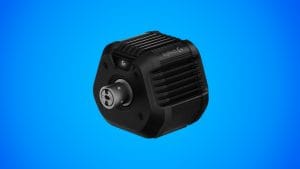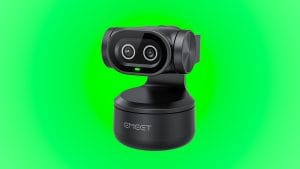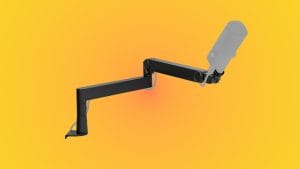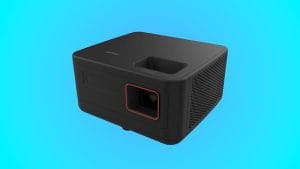ROG Carnyx Professional Cardioid Condenser Gaming Microphone
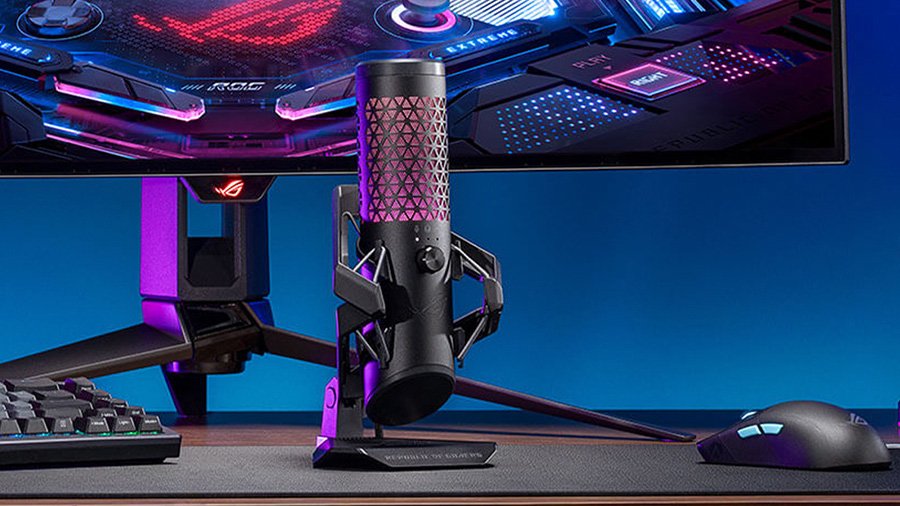
design
As a complete package, the ASUS ROG Carnyx is one of the pointier microphones I’ve ever held. While the mic itself is a pretty simple tube, the included (non-optional) shock mount and stand has corners everywhere you look. It’s all a bit funky and it makes for a unique and unashamedly ‘gamer’ look that I actually quite enjoy. I’m always on the lookout for a metal casing on more premium offerings so was glad to see the ROG Carnyx wrapped in a sleek matte black metal jacket, though it’s then spoiled by cheap feeling plastic panels on the top and bottom.
Some of the marketing photos don’t quite do it justice; the ROG Carnyx is a giant microphone and I’d go as far as to say it’s too big. Ignoring the stand for a moment, the ASUS ROG Carnyx itself is 218mm long, nearly half a centimetre longer than the huge RODE Procaster and I have to ask why. It’s a massive lump to try and work into a setup and while I’ve got no idea what’s going on inside; it’s hard to see what it could possibly need all that space for that others don’t. Add in the stand and the top of the Carnyx now sits 25cm off the desk – it’s a giant.
Like the SteelSeries Alias the ROG Carnyx sits on a desktop stand that holds it up to you like a newborn baby lion about to rule the kingdom. It’s nicely built with an all-metal construction and a wide enough base that meant it remained stable in all positions. Just like the Alias however, adjustments on the ASUS ROG Carnyx are extremely limited. There’s a restricted amount of back and forth tilt and that’s it. It’s disappointing to see and draws the same criticism I had of the Steelseries that it means always covering the bottom of your monitor with the top of the microphone.

If you’d rather avoid the stand altogether you can do away with the baseplate and bolt the ROG Carnyx directly onto a mic arm. This isn’t quite as user friendly as it might have been though as the single screw holding it all together needs a tool to undo and surely would have benefited from a thumb screw of some sort. That aside, I had no issues mounting it to an Elgato Wave Arm. The shock mount is essentially part of the microphone so you’ll still benefit from that when using a mic arm as well.
Around the back of the microphone you’ll find the USB-C port and a 3.5mm headphone jack for real time monitoring, always a welcome addition. The multi-function dial on the front of the ROG Carnyx is nicely textured with enough resistance to avoid accidental adjustments. It’s here you’ll choose between gain and headphone levels as well as toggle the onboard high pass filter. Be warned though, some actions are triggered by pressing this dial like a button which will send your Carnyx flying unless you’re holding on to it.
The top of the ROG Carnyx houses a touch-sensitive mute button which some may find useful but needs a good deal of precision to work with. While the panel itself is 55mm wide, the working area of the mute button is only the middle 20mm or so with no indicator of what’s hidden button and what’s just plain plastic. Trying to use this on the fly I found I almost always needed multiple taps to get it to trigger unless I paid real attention to what I was doing.
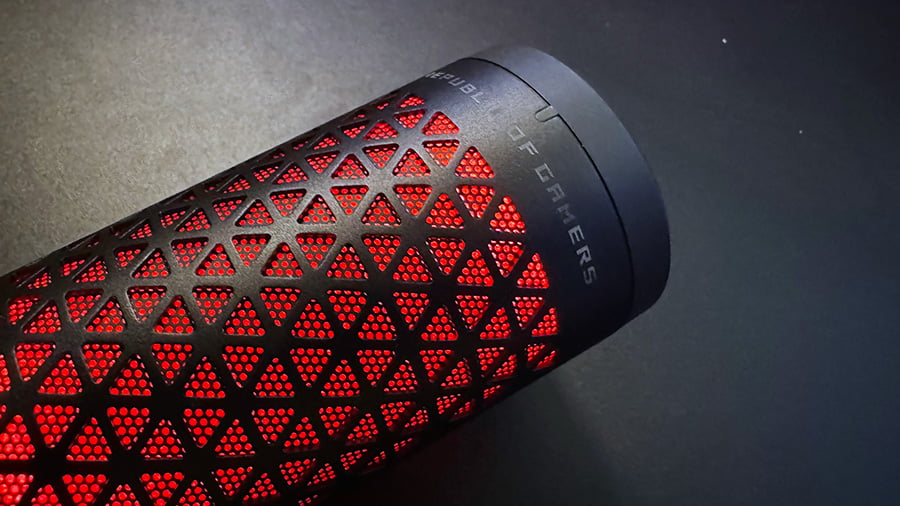
You’ll know when you’ve found the right spot at least because the inside of the ROG Carnyx will glow aggressively red from behind the integrated pop filter mesh. The effect is eye-catching as the LEDs here are nicely saturated with strong colour and good overall brightness, it’ll also briefly flick back to green when you unmute. This lighting effect should also be customisable and able to stay on via the ASUS Armoury Crate app but after more than an hour of uninstalling, reinstalling and trying just about everything I couldn’t get the software to recognise the Carnyx. I don’t need pretty lighting effects that badly, so I gave up.
performance
The ASUS ROG Carnyx is a USB microphone so setup is about as simple as you can get. There’s a generously long 3m USB-C to USB-A cable in the box and while its braided which is good, it’s also overly rigid with a load of shape memory; which is bad. I had no problems with OBS recognising the Carnyx as a new microphone as soon as I plugged it in and yet ROG’s own Armoury Crate still never saw it, odd. This isn’t a massive issue though as plug-and-play performance was great and the small handful of EQ and filter settings available in the app can be easily replicated elsewhere anyway.
There’s an impressively large 25mm condenser capsule tucked away inside the ROG Carnyx and it produced a good standard of audio across my testing. At a raw level everything I captured was clean and nicely rounded and offered a good starting point for tinkering with post-production filters and EQ. As a condenser microphone the pickup area is fairly large and while there’s definite value in proximity, the tone stayed pretty stable across a wide working area.
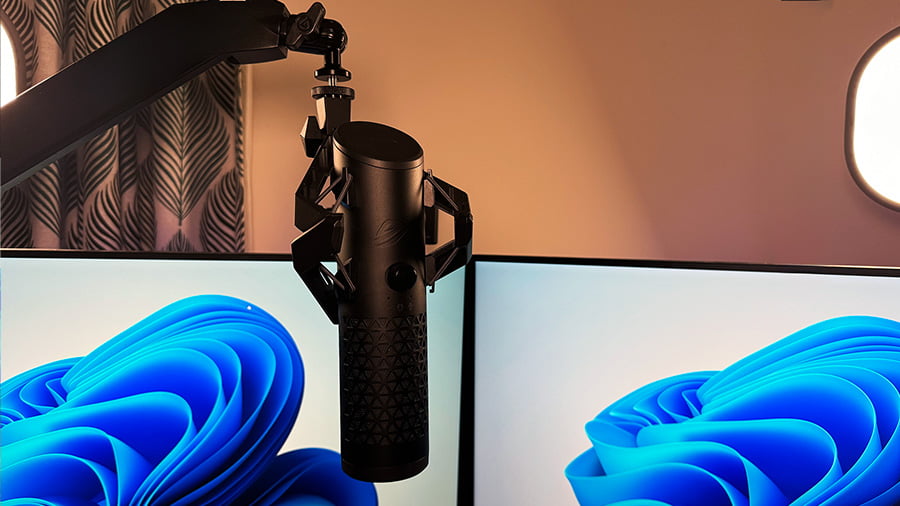
Using the ASUS ROG Carnyx for streaming I was impressed at the richness of my voice overall, particularly if I maintained a close distance, around 10-15cm. At this range it started to mimic those podcast voice characteristics of a dynamic microphone and the output felt far more impressive. My tone was rich, deep and full without sounding forced; it wasn’t quite as good as the RODE PodMic USB but it’s damn close if you’re deliberate with your mic etiquette. The built-in pop filter hiding inside the patterned grille did seem to do a decent job are rejecting plosives and I only noticed distortion when really starting to up my aggression in an attempt to catch it out.
Moving back to around 30cm away however introduced a fair chunk of roominess and stripped out some of that luxe. It still sounded clear and crisp overall and I have no major complaints but my voice just began to sound a little more withdrawn and lost some of the broadcast magic. This is par for the course with most condenser streaming microphones though and I found the same with the comparable SteelSeries Alias mics. The trade-off benefit to condense capsules however is you can pay far less attention to addressing the microphone properly and in testing I was able to happily forget where the Carnyx was, move around in front of my face cam and still stream clear vocals. The simple summary is for a majority of creators the ROG Carnyx will sound excellent and deliver results good enough to justify the premium level price tag.
The ASUS ROG Carnyx features an onboard high pass filter but I’d exercise caution in blindly using it. I recorded a number of samples both with and without the filter enabled and found often my voice sounded smoother with it kept off. This will likely be setup dependent though, my streaming space has some acoustic treatment and is away from sources of disruptive noise so the trimmed off audio didn’t offer benefits to me. If you struggle with rumbly noise like fans or traffic noise however you might see more benefits.
summed up
In a crowded streaming microphone space the ROG Carnyx holds its own as a very good but somewhat unremarkable option. The large cardioid diaphragm is capable of delivering strong, clean sound and most gamers will likely be impressed by what it’s capable of.
It’s giant though, too big really, and that’s going to present issues for gamers that aren’t blessed with massive amounts of desk space. For a comparable price there are equally strong options from brands like Elgato and SteelSeries that offer equally strong performance in a far smaller package, so while I have no major complaints about the audio performance and you’ll be happy with what you get from the ROG Carnyx, it may be worth exploring around.







